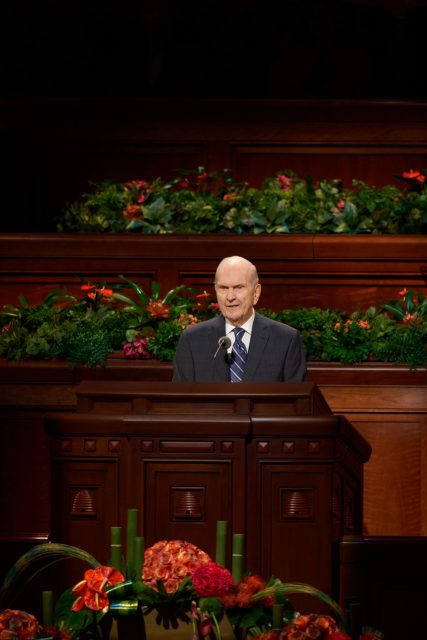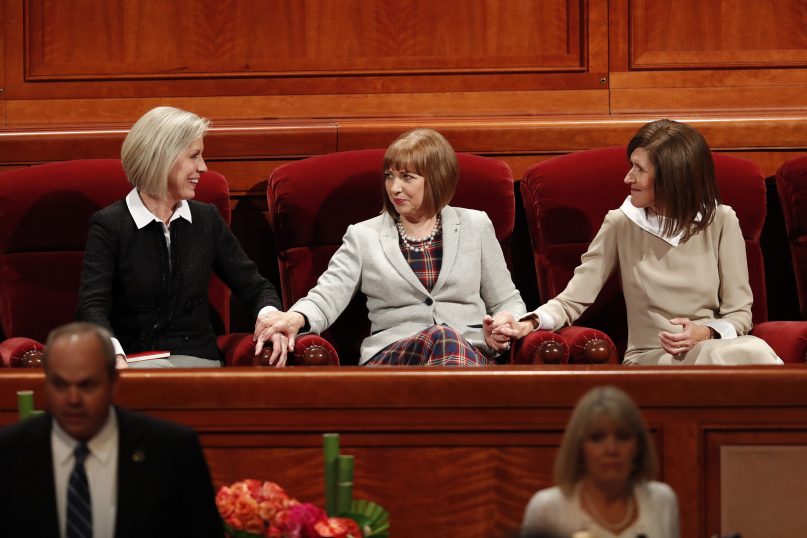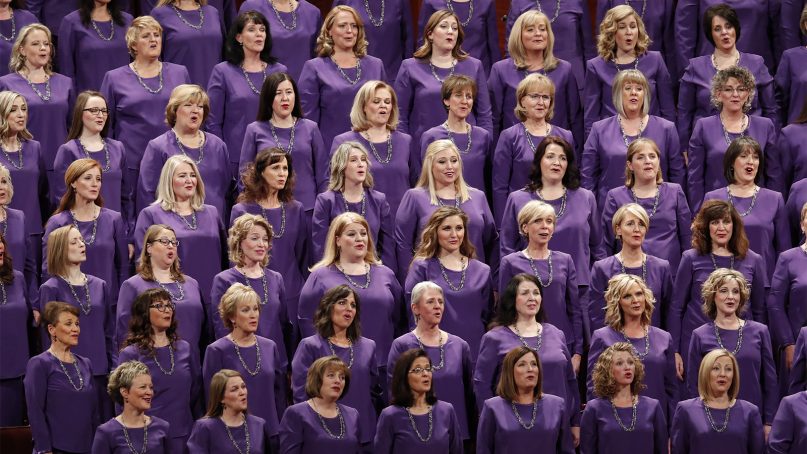It was an exciting General Conference for members of the Church of Jesus Christ of Latter-day Saints this weekend, with several major announcements as well as undercurrents of larger themes.
The name “Mormon” is out. (As is the Mormon Tabernacle Choir — which has been renamed The Tabernacle Choir at Temple Square.)
Church services are going to be shorter.
And the focus of the faith will be at home—not primarily at church.
Here are nine highlights, with more details of the changes announced this weekend.
“Mormon” has become a four-letter word.
In the Sunday morning session, President Russell M. Nelson hammered hard on the name of the Church, urging members to stop using the nickname “Mormon.”
Instead, they should use the full name of the Church.
It’s not a rebranding effort, Nelson emphasized. Nor is it a trivial matter.
Nelson said it’s the Lord’s will that the entire name be used, since it places focus on Jesus Christ.
The president of the Church is not afraid to tip sacred cows.
Ironically, it was the Church itself that, beginning around 2010, began a full-court-press rally around that very word “Mormon.”

President Russell M. Nelson addresses the Sunday morning session of the 188th semiannual general conference of the Church of Jesus Christ of Latter-day Saints on Oct. 7, 2018, in Salt Lake City. ©2018 by Intellectual Reserve Inc.
In endeavors like the successful “I’m a Mormon” ad campaign and the Meet the Mormons movie, the Church introduced a curious public to individual Mormon people, showcasing their faith and their contributions to the world.
Now President Nelson is not only moving in a different direction, but he also hinted that the old direction may have been a “major victory for Satan.”
That’s a 180-degree turn the likes of which is almost unheard of in modern Mormonism, where change happens glacially and current leaders simply don’t overturn the legacy of deceased ones.
What usually happens is that a teaching is quietly de-emphasized while a new one gains momentum to take its place, but the old one is still “on the books,” sometimes for decades.
Nelson is doing something altogether different and decisive. He seems unafraid to say that the previous way of doing things was wrong— and it should be remembered that he would have been part of the decision making on the use of “Mormon” personally, as he’s been a member of the Quorum of the Twelve since the Reagan administration. He’s rebuking himself too here.
This raises the question: if a Mormon president is unafraid to boldly — and publicly — challenge a policy of previous church leaders, what other changes may be coming?
Two-hour church will be a reality.
LDS Church members around the world whooped for joy on social media at the unexpected-but-expected announcement that Sunday meetings would be shortened to two hours from three, which is the schedule that’s been in place worldwide since 1980.
Elder Quentin Cook got to announce the news, to a jubilant reaction.
The new meeting schedule for the Church will begin in January 2019, with 60 minutes for sacrament meeting, 10 minutes for a break, and 50 minutes for classes and other meetings organized by age and gender.
Members’ faith should be home-centered and church-supported, rather than the other way around.
Having one less hour of church on Sunday does not mean Mormons get to simply hang out and chillax.
Rather, they are to take the initiative in their families to study the gospel at home, aided by a new “Come, Follow Me” curriculum that will be given to all adult members by the end of the year. For next year, the focus will be on the New Testament.
The door also seems open for gospel study groups that aren’t just restricted to family, which would be a change. In the 1990s, Mormon leaders discouraged the formation of such groups, but given the growing number of single members and nontraditional families, they would fill a real need in terms of fellowship and spiritual growth.
There were very few women speakers.
Many observers noticed that only one woman, President Bonnie Cordon of the Young Women, addressed the entire mixed audience over the course of the weekend. This is in contrast to 26 talks given by male leaders during the daytime general sessions.
In the Saturday evening women’s session — which was included during the conference weekend for the first time, instead of being held the weekend before — three women spoke, and three men. In the past, only one man has spoken in the women’s meeting.

Women leaders of the Church sit in the front during the general women’s session of general conference on Oct. 6, 2018. Pictured from left to right: Sister Joy D. Jones, president, Primary general presidency; Sister Cristina B. Franco, second counselor, Primary general presidency; and Sister Michelle D. Craig, first counselor, Young Women general presidency. ©2018 by Intellectual Reserve Inc.
It didn’t help matters that the male leaders’ talks were very much about defining for women what their roles should be — marriage and motherhood being paramount — while the women’s talks were more far-reaching, focusing on women’s spiritual development and the many ways they can serve others.
The church still endorses traditional marriage and gender identities.
President Dallin Oaks’ Saturday talk proved controversial in its firm denunciation of same-sex marriage, a topic avoided by most other speakers. (In the Church, all three members of the First Presidency — the prophet and both of his counselors — are addressed by the title “president.”)
“Under the great plan of our loving Creator, the mission of His restored church is to help the children of God achieve the supernal blessing of exaltation in the celestial kingdom, which can only be attained through an eternal marriage between a man and a woman,” he said.
Oaks, who as the most senior apostle is next in line to be the LDS prophet, also reiterated the teaching in the 1995 document “The Family: A Proclamation to the World” that gender is an eternal characteristic of human beings. He warned that no society should “make changes that confuse or alter gender or homogenize the differences between men and women.” He indicated that opposition to the teaching that gender is eternal may be Satanically generated.
There was an outpouring of love for Elder Ballard.
On Sunday, Elder M. Russell Ballard gave what many considered the most emotionally heartfelt talk of the conference, focusing on the redeeming work Mormons do for the dead in temples.
It was personal and poignant for two reasons.
First, Elder Ballard’s wife, Barbara, died just days ago at age 86, and he shared anecdotes and photos from their life together. The couple married in 1951 and had seven children. In his talk, Elder Ballard testified of his belief in eternal families and his abiding love for his wife.
Second, it’s been almost exactly 100 years since the October 1918 revelation received by President Joseph F. Smith about how the dead will be redeemed through temple ordinances (a teaching that is canonized in Mormon scripture). Joseph F. Smith is Ballard’s own great-grandfather.
President Nelson called for a 10-day social media fast for women.
Although details are unclear, President Nelson called for the women of the Church to abstain from social media for 10 days to refocus their priorities on the Savior. He also asked them to read the Book of Mormon before the end of 2018, attend the temple regularly and be part of Relief Society.
This social media fast is similar to (but longer than) a charge given to the youth of the Church earlier this year.
Church members got glimpses of new apostles Soares and Gong.
Finally, Saturday conference talks from new apostles Ulisses Soares and Gerrit W. Gong gave church members a chance to get to know these leaders, who were ordained to the Quorum of the Twelve in April.
Elder Soares, a native of Brazil, drew on a metaphor of rivers in South America blending together and becoming powerful to encourage Latter-day Saints who were born into the church to welcome new converts and allow their strength to make them mighty. And in an unusual conference message, Elder Gong called upon members to stretch their creativity when engaging a life of faith.





